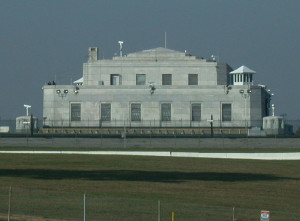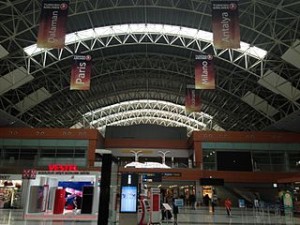We take a closer look at 5 iconic and secure buildings in the world and examine what they are designed to protect against.
When one is interested in secure buildings, it’s hard not to look at what distinguishes large buildings from the less big.
Physical security is about creating an acceptable balance between the protective features of a building’s perimeter, shell, and core. But as we began to look at which secure buildings were the most iconic, other dimensions also proved to be relevant.
An example of this is the value and importance of what the building protects. Another is the building’s cultural or symbolic significance. A third is what the building protects against.
Our list is by no means exhaustive, but we think it’s a good start to describe some buildings that are both iconic and secure.

1. Fort Knox – U.S. Bullion Depository, Kentucky
Located in Kentucky, Fort Knox is one of the most well-known buildings in the world and certainly one of the most secure – for good reasons. As the U.S. Bullion Depository, it is estimated to hold about 4 percent of all gold ever refined, as well as numerous historical treasures.
The building is surrounded by multiple fences (some of which are electrified), and the United States Mint Police patrol the perimeter, forming the first layer of security. The site also houses the U.S. Army, adding even more security: In addition to around 30,000 soldiers, tanks, and attack helicopters, among other things, can be found on-site.
Inside, there are multiple armed guards, intricate alarm systems, and video cameras. Granite walls (4 feet thick, reinforced with 750 tons of steel) make the shell bombproof. The fireproof, bulletproof black windows are sealed from the inside out.
Finally, doors and vaults: The main door weighs nearly 22 tons and is made of blast-resistant material. Combinations are changed daily, and multiple employees must enter separate combinations to open the vault. Less is known about the other vaults, but specifications show that some of them are 27 inches thick and resistant to atomic explosions.

2. Cheyenne Mountain Complex
As the center for the U.S. Space Command and NORAD, the complex was designed with physical security in mind from the start.
While NORAD and USNORTHCOM headquarters were eventually moved to Peterson Air Force Base, the site is still secure – simply because of its location inside a mountain.
The complex is located under 600 meters of granite and houses at least fifteen three-story buildings designed to withstand explosions and earthquakes. Intricate systems of massive springs prevent the buildings from collapsing during seismic events.
The entire complex is blast-proof, classified as a “nuclear bunker,” and can also withstand EMP attacks. Blast valves ensure that the air inside remains free of contaminants in case of a biological or nuclear attack.
The interior consists of a large number of tunnels, side tunnels, and chambers, all protected by alarms and surveillance systems as well as armed personnel.
Finally, one of the biggest security features is the complex’s ability to remain functional in all situations: A massive support area contains a power plant for the entire facility, heating and cooling systems, battery banks and redundant power generators, diesel reservoirs, and a dedicated water supply. This 1.5 million-gallon reservoir provides water for personnel and machinery but can also be used in case of fire.

3. Svalbard Global Seed Vault
Opened in 2008, the Svalbard Global Seed Vault was designed to preserve plant seeds in case of major crises leading to destruction (or contamination) of other seed banks and gene banks around the world.
The seed vault does not have full-time staff. However, its security systems are advanced, fully automated, and self-sustaining. The site is designed to last for hundreds – if not thousands – of years and could withstand global catastrophes: fires, nuclear attacks, global warming, and more. The entrance is located 130 meters above sea level, protecting it from potential floods.
Tunnels extend five hundred meters into a mountain. Built of concrete, its security systems include airlocks, blast-resistant doors, fences, motion detectors, and a protection system. Internal breaches are unlikely: access and door codes are spread among multiple employees, so no single person has all the codes necessary to access the vault.
Like the Cheyenne Mountain Complex, the location of the vault provides one of its most vital layers of physical security: The vault is located deep inside a mountain in the Norwegian Arctic, approximately 600 miles from the North Pole. Low temperatures, remoteness, and a hostile environment make it extremely difficult for uninvited guests to reach it – and much harder to break into it.

4. Sabiha Gökçen International Airport
When considering physical security and building protection, it’s crucial to consider the environmental hazards that can harm a structure.
Sabiha Gökçen International Airport is a perfect example of this: It is the world’s largest earthquake-resistant building. Istanbul itself is located at the convergence of three tectonic plates, making the city and its infrastructure highly vulnerable to seismic disasters.
Not only is the airport capable of withstanding an earthquake with a magnitude of 8.0 on the Richter scale. It was also designed to remain functional afterward.
The two-million-square-meter building was not constructed directly on the ground but on over 300 isolators, whose bearings move during earthquakes. This means that the entire building also moves from side to side, preventing damage from external forces. Thanks to its isolators, the airport only needs to withstand one-fifth of the acceleration it would normally undergo. Additionally, the weight of the entire structure is reduced by 40% thanks to its lightweight steel frame.
The airport was the first building in the world to use this particular protection system. It has paved the way for other critical infrastructure. Similar security measures are now used in offshore platforms in San Francisco International Airport Terminal, Bola Viaducts, Mills-Peninsula’s Sutter Health medical facility, and more.

5. Federal Reserve Bank of New York
As the largest and most active of the 12 Federal Reserve Banks in the United States, the Federal Reserve Bank of New York must be incredibly secure. As of 2012, its vault contained over half a million gold bars. How do you support the intense weight of all that gold? It helps that the vault rests directly on Manhattan Island’s bedrock.
On the outside, the building may not look as fortified as Fort Knox because it’s in a densely built urban area. Few obvious guards patrol the site, and there are a limited number of barriers and bollards. The inside is a different story.
The bank and the vaults are secured by a dedicated protection force – armed, of course. Alarm systems, security cameras, motion and biometric sensors monitor the complex 24/7. When alarm systems are triggered, it allows the guards to seal off all areas and exits in less than 25 seconds.
The main vault is located at the bottom of a three-story bunker of other vaults, “stacked” on top of each other like strongboxes. The walls around it are made of reinforced concrete. The main vault itself has no door. The only access is through a narrow passage – part of a 90-ton steel cylinder, a single-entry system that rotates as needed, inside a steel and concrete frame. Once sealed, the vault is both waterproof and airtight.
Photo Credit: All images are shared under CC BY-SA 3.0 license, except for the Cheyenne Mountain Complex image, which is in the public domain. Authors: Cliff (Fort Knox), Bjoertvedt (Seed Vault), Aeriport (Sabiha Airport), Gryffindor (NY Federal Reserve).


